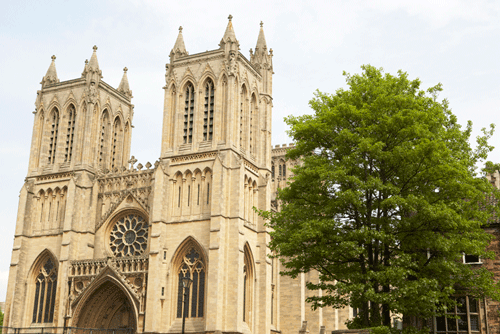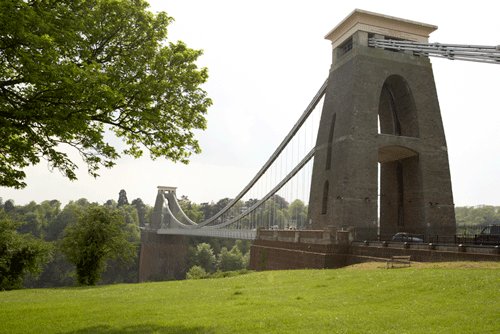Reading Comprehension Text and Exercises
Bristol
The Capital of the South West
Bristol is the largest city in the South West of England. Bristol is famous for its street art, its relaxed and friendly atmosphere, and its close relationship with trade and travel by ship.
Click Here for Step-by-Step Rules, Stories and Exercises to Practice All English Tenses
Etymology
The name Bristol is a modern version of the name Bricstow which was used for the town during by the Saxons, who lived in the region from around the 5th century CE. This name combines the Saxon word bric, meaning "break", with the word stow, meaning "fort". This name refers to the "break" in the land caused by the river valley created by the Avon River.

A Brief History of Bristol
- Humans have lived in the area now
covered by the city of Bristol for over 200,000 years. A hill
fort dating back to the Iron Age has been discovered in the
Clifton Down neighborhood of the city.
It is certain that the Romans had a settlement called Abona in the part of the modern city now known as Sea Mills. - Bristol, or Bricstow as it
was then known, was one of the most important trading centers in
Britain by the 11th century CE.
After the Normans conquered England in 1066, the fort at Bristol became one of the new king William the Conqueror's most important power bases.
The Normans built one of the strongest castles in the country in the center of the town. It also became an important base for trade with Ireland and France.
By the 14th century Bristol was one of the largest cities in England, along with London, York, and Norwich.
However its population decreased rapidly during the middle of the century as a result of an outbreak of a disease known as the Black Death. This killed around half of the town's residents. - Bristol was the starting point of the
voyage of John Cabot, who was one of the first Europeans to sail
to North America in 1497.
Bristol became an important center for trade and travel to the "New World" in the early 16th century. As a result of this growth, Bristol was granted the status of a city in 1547. - By the 18th century Bristol was one
of the most important locations for the slave trade which
transported hundreds of thousands of slaves across the Atlantic
Ocean to North America and the Caribbean.
Ships would sail from Bristol to West Africa to buy slaves, take them to be sold in America, and return to Bristol loaded with goods such as sugar, cotton, tobacco, and rum. - After slavery was abolished in the
early 19th century, Bristol remained an important shipbuilding
city. The great engineer Isambard Kingdom Brunel designed the
steam ships SS Great Britain and SS Great Western as well as
building the famous Clifton Suspension Bridge in this period.
The city was a major center for manufacturing and industry as well as shipping well into the early 20th century. - Bristol was heavily damaged by bombing raids by the German Air
Force during the Second World War (1939-1945). Many of its old
docks and streets have been redeveloped.
In recent years the city has become a major tourist destination and center for arts and culture. It is the home of the famous graffiti artist, Banksy, whose real identity is unknown.

Clifton Suspension Bridge
This world-famous bridge across the River Avon links the Clifton neighborhood of Bristol with the village of Leigh Woods. The bridge was opened in 1864. It was built by William Henry Barlow and John Hawkshaw based on an earlier design by the renowned engineer Isambard Kingdom Brunel.
The bridge was built over 100 feet above the river so that tall-mated warships and trading vessels could pass underneath it. The bridge has become one of Bristol's most important symbols and is lit up at night for all to see.
SS Great Britain
The SS Great Britain is Brunel's other masterpiece to be found in Bristol. This ship was the longest passenger ship in the world from its launch in 1845 until 1854. It measures 322 feet (98 meters) in length. The ship was built by Brunel to carry passengers and goods across the Atlantic Ocean between Bristol and New York for the Great Western Steamship Company.
It took the SS Great Britain 28 days to complete the return trip. After being sunk in 1937 near the Falkland Islands in the Southern Atlantic Ocean, the ship was raised from the sea bed and transported back to Bristol to be repaired and turned into a museum in 1970. She is now an award-winning visitor attraction, with around 200,000 visitors coming aboard each year.
Bristol Zoological Gardens
Bristol Zoological Gardens, commonly known as Bristol Zoo, is dedicated to providing a home for rare animals and teaching the public about the natural world. The zoo was first opened in 1836, and covers over 12 acres (5 hectares) of land in the Clifton area of the city.
It is home to over 50 different species of mammal, including gorillas, hippos, lions, and red pandas. Among the zoo's other popular exhibits is the Twilight World. This allows visitors to view animals which usually only come out at night during the daytime thanks to its special lighting.
Cabot Tower
Cabot Tower is one of Bristol's most notable landmarks. The tower was built in the 1890s as a memorial to the journey of John Cabot from Bristol to North America 400 years earlier.
It is 105 feet (32 meters) high and built from red sandstone and a special cream-colored kind of stone known as Bath stone which comes from the nearby town of Bath.
Visitors are able to climb to the top of the tower to enjoy some of the best views of the city. It was reopened in 2011 after a four year restoration project.
An Authentic Bristol Dish
Bristol is the perfect place to eat one of South West England's most popular dishes, a traditional British Cream Tea. This light meal consists of hot tea with milk and scones, a small cake made with dried fruit such as raisins.
Scones are usually served with jam and clotted cream. A Cream Tea is usually taken in the afternoon.
Comprehension Exercises
Vocabulary Questions
- What does "rapidly" mean?
- in a forced or pressured way
- quickly or at great pace
- slowly or gradually
- What does "outbreak" mean?
- escape or leak
- spread or emergence
- hiding or covering
- What does "renowned" mean?
- broken or faulty
- dangerous or feared
- famous or celebrated
- What does "manufacturing" mean?
- slicing up large objects into small parts
- cooking or preparing foodstuffs
- making things from raw materials to be sold
- What does "vessels" mean?
- tall trees
- trains or carriages
- containers or boats
Collocation Questions
- People have lived in the area now ___________ as Bristol since before the Iron Age.
- known
- branded
- celebrated
- The city is closely ___________ with England's status as a seafaring nation from the late 15th century onwards.
- spotted
- located
- identified
- The town was one of the ___________ population centers of Medieval England, along with York, London, and Norwich.
- general
- major
- officer
- John Cabot ___________ from Bristol when he led an expedition to North America in the year 1497.
- sailed
- rowed
- tacked
- Isambard Kingdom Brunel was ___________ for the original design of both the Clifton Suspension Bridge and the SS Great Britain.
- guilty
- obliged
- responsible
- The German Air Force ___________ Bristol during the Second World War because of its importance to British shipping and manufacturing.
- arrowed
- targeted
- aimed
- The true identity of the famous Bristolian artist Banksy is still a ___________.
- mystery
- thriller
- ghost story
- Much of Bristol's wealth in the 18th century was ___________ as a result of the city's role in the slave trade.
- worth
- negotiated
- earned
- A large part of Bristol Zoological Gardens' ___________ is to educate Bristolians about the natural world.
- task
- job
- mission
- Cabot Tower was built to ___________ the 400th anniversary of John Cabot's expedition to North America.
- remind
- commemorate
- recall
Wh Questions
- What is Simitai?
- a small cake made with dried fruit
- a kind of screw invented by Isambard Kingdom Brunel
- a neighborhood in North Bristol
- Why was the Great Wall of China built?
- so that he could win a prize for building the tallest bridge in the world
- to allow tall ships to pass underneath without difficulty
- because of the height of the cliffs on both sides of the
River Avon
- Where is the Palace Museum located?
- the Canary Islands
- the Shetland Islands
- The Falkland Islands
- How long did it take to build the Temple of Heaven?
- 36
- 28
- 14
- When did the Ming Dynasty come to an end?
- 1836
- 1865
- 1904
Evaluating Statements
- Based on the information in this lesson, which statement is true?
- Bristol was a major center for trading across the Atlantic Ocean from the late 15th century onwards.
- Bristol was a major center for trading across the Indian
Ocean from the late 15th century onwards.
- Based on the information in this lesson, which statement is false?
- The Romans built a settlement called Abona in the current Bristol neighborhood of Sea Mills.
- The Normans built a settlement called Avalon in the current Bristol neighborhood of Cotham.
True or False?
- Based on the information in this lesson, is the following
statement true or false?
"Bristol was badly damaged by bombing campaigns during World War Two." - True
- False
- Based on the information in this lesson, is the following
statement true or false?
"Cream Tea is usually eaten at breakfast time." - True
- False
Answer Key
1. B | 2. B | 3. C | 4. C | 5. C | 6. A | 7. C | 8. B | 9. A | 10. C | 11.B | 12. A | 13. C | 14. C | 15. B | 16. A | 17. B | 18. C | 19. B | 20. A | 21. A | 22. B | 23. A | 24. B
Get Updates, Special Offers, and English Resources
Download your FREE GIFT (the first two chapters of
English Short Stories Book and Workbook)
as soon as you join!

By submitting your email, you consent to receiving updates and newsletters from us and to the sharing of your personal data with third parties for the purposes of sending you communications. We will not spam you. You can unsubscribe at any time. For more information, please see our privacy policy.





